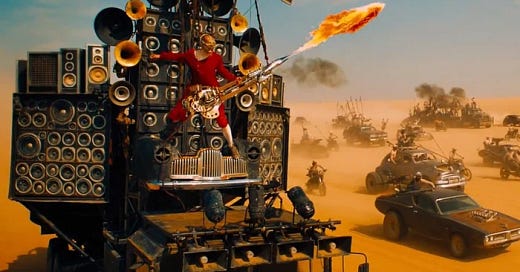#40: All the world is blood.
This week: Myth, machines, and Miller — the Mad Max sequence as cinema’s most potent techno-ritual.
We’ve reached Issue #40 — not a neat closure, but another turning of the wheel.
And what better symbol of recursion than Mad Max, a cinematic loop stitched in dust, fuel, and fire. With Furiosa’s release failing spectacularly at the box office, we look instead at why these films matter more than ever. They’re not just post-apocalypse fantasies. They’re rituals for our broken time.
Plus: artists turning technologies into ceremonies, Philip Parreno, bio-sonic sensors, and some concrete ghosts from earlier issues.
IDEAS: All the world is blood
Furiosa, last year’s fifth Mad Max movie, lost $120 million.
That’s not the point.
Mad Max is the most sustained act of cinematic mythmaking in our lifetime — a ritual sequence etched into metal, bodies, and sand. Not a franchise in the Marvel sense. Something older. More circular. A myth that repeats, sheds skin, and returns.
Every film in the sequence tells the same story: civilisation collapses, a woman leads the way out, Max wanders on. But the materials mutate. The textures shift. The technologies rust.
This is cinema as recurrence. A cracked loop in the desert.
Like Cormac McCarthy’s Blood Meridian, Miller’s saga loops through desert horror, violence, and rebirth. Both McCarthy and Miller write in blood and sand, repeating acts of brutal beauty that circle the void but never resolve it. We don’t watch these stories. We enter them, again and again.
But the important thing about Mad Max is: he didn’t come from high culture. He came from the edge. A 1979 Australian B-movie made with no money, no time, no studio plan. Shot with ex-doctors, wannabe bikers, and a then-unknown Mel Gibson. The original Mad Max was all speed and abrasion — DIY editing, handheld chaos, and a vision of the end made entirely out of junkyard parts.
By Fury Road, the world had grown around it. The scale got huge. But the engine remained the same. A delirious choreography of machines, violence, and ritual — where every part of the set becomes mythic. The steering wheels are totems. The flamethrower guitar is a relic. Technologies don’t vanish. They become ritual.
We said this in issue #20, looking at Edward Burtynsky’s industrial ruins. We saw it in issue #25, in the Backrooms aesthetic — low-res horror turned into cultural dreamspace. It’s there in issue #21, with Demon Slayer, where anime stylisation transforms trauma into timeless loop.
Mad Max is all of that. But physical. Felt. Dirty. You can smell the petrol.
And like Deleuze’s time-image, what matters here is not plot or consequence, but pressure. Duration. Accumulation. George Miller is no longer just a director — he’s a technician of time. And if Deleuze thought that mantle belonged to Resnais or Antonioni, then Fury Road proves that today, it’s held by Miller, Nolan, Villeneuve and the most radical action filmmakers alive.
But let’s not forget: this is still a film where a man strapped to a truck screams through the desert while playing a flame guitar. There’s joy in the excess. That’s the point. It’s myth as spectacle, not message.
Which is why the failure of Furiosa at the box office doesn’t feel like an ending. If anything, it’s a reminder. These films don’t operate on a linear plane. They’re like dreams or rituals. They circle. They break form and rebuild. Each time, the same. Each time, different.
Like Max himself: they come from nowhere, speak little, disappear when the work is done.
INCOMING: WHAT WE’RE TRACKING
Technologies as ritual:
Sofian Audry’s AI artworks emerge from recursive learning and feedback loops, reconfiguring ritual into code — particularly their self-modifying robotic ecosystems.
Mika Tajima’s 2016 work Meridian used bio-sensing data to shape immersive spaces that pulse with visitors’ emotional states.
Patricia Domínguez fuses techno-shamanic imagery with digital botany and spiritual healing in her speculative visual research.
Rachel Rose constructs sensorial films and installations that feel like myth built from the detritus of contemporary media.
I was lucky to see Philippe Parreno’s show at Haus Der Kunst in Munich last month. He works where objects perform themselves — ritualised automata of light, air, algorithm.
SIGNAL RETURNS
Highlights from earlier transmissions:
#9: Oh to Escape Utterly: From dream-horror memes to VR ritual spaces.
#14: Ride the Silver Rocket: Pussy Riot as digital prophets of protest spectacle.
#17: More Songs About Buildings and Food: Techno-ritual architecture, Nick Cave, and HoloTile.
#20: The Rapture of Metals: Edward Burtynsky’s visual theologies of waste.
#21: Delirious: Demon Slayer and the dream-logic of anime affect.
#22: Underwater Dancehall: Dub, Dolby, and deep immersive soundspaces.
ENDNOTE
This week’s title is an adaptation of Max’s most poetic line from Fury Road:
My name is Max. My world is fire. And blood.
In Mad Max: Fury Road, the Doof Warrior plays a guitar that shoots fire. It’s absurd. It’s sacred. It’s entirely serious.
That moment isn’t comic relief — it’s liturgy. A procession. The flamethrower guitar is a ritual object, carried into battle, looping noise into meaning.
Music has always had that role: technology weaponised as myth.
The closest analogue? Not Hans Zimmer, but Sunn O))).
Not Vangelis, but Ornette Coleman.
Coleman’s soundtrack for Naked Lunch — twisted reeds and desert hallucinations — isn’t just accompaniment, it’s a fevered landscape. Just as Miller built myth from engines, Coleman built it from breath, distortion, and ritual tone.
We’ll come back to that in a future issue.
Creative R&D is a reader-supported chronicle of experimental creativity, emerging tech, and aesthetic rituals. If you’ve enjoyed this, please share it or become a subscriber.
See you next week for a recap of issues 1-40.
Then we’ll begin again with Issue #41: Time Is a Lie.





